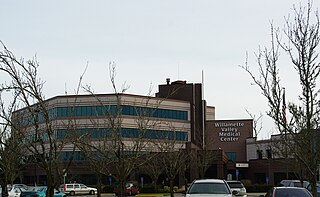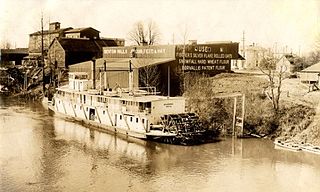
Nestlé S.A. is a Swiss multinational food and drink processing conglomerate corporation headquartered in Vevey, Switzerland. It has been the largest publicly held food company in the world, measured by revenue and other metrics, since 2014. It ranked No. 64 on the Fortune Global 500 in 2017 and No. 33 in the 2016 edition of the Forbes Global 2000 list of the largest public companies.

The Tillamook County Creamery Association (TCCA) is a farmer-owned dairy cooperative headquartered in Tillamook County, Oregon, United States. The association manufactures and sells dairy products under the "Tillamook" brand name. Its main facility is the Tillamook Creamery, located two miles north of the city of Tillamook on U.S. Route 101.
Brooklyn is a mostly residential neighborhood in southeast Portland, Oregon. It sits along the east side of the Willamette River in the vicinity of Reed College. Founded as a neighborhood in the late 1860s, the neighborhood today is a middle-class area comprising mainly single family homes, interspersed with remaining industrial sites along the river and a large railyard. This railyard was home to Southern Pacific 4449 as well as several other large antique steam and diesel-electric locomotives.

St. Johns is a neighborhood of Portland, Oregon, United States, located in North Portland on the tip of the peninsula formed by the confluence of the Willamette River and the Columbia River. It was a separate, incorporated city from 1902 until 1915, when citizens of both St. Johns and Portland voted to approve its annexation to Portland, which took effect on July 8, 1915.
Kenton is a neighborhood in the north section of Portland, Oregon, United States. The neighborhood was originally a company town founded in 1911 for the Swift Meat Packing Company.
The Amalgamated Sugar Company is an American sugar beet-refining company run on a cooperative basis. It was founded in 1897 in Ogden, Utah, and is now located in Boise, Idaho. The company markets its sugar under the White Satin brand.

The Coquille River starts in the Siskiyou National Forest and flows hundreds of miles through the Coquille Valley on its way to the Pacific Ocean. Bandon, Oregon, sits at the mouth of the Coquille River on the Pacific Ocean. Before the era of railroads and later, automobiles, the steamboats on the Coquille River were the major mode of transportation from Bandon to Coquille and Myrtle Point in southern Coos County, Oregon, United States.

Willamette Valley Medical Center is a for-profit Level III acute care hospital in McMinnville, Oregon, United States, adjacent to the McMinnville Airport on Oregon Route 18. Opened at a different location as McMinnville Community Hospital, the four-story medical center has 60 licensed hospital beds. It is owned by Lifepoint.
Harry Taylor Bagley was an American attorney and politician in the state of Oregon. A native of Ohio, he was raised in Washington County, Oregon, where he practiced law and was a local official. He also served as a two-term mayor of Hillsboro, the county seat, and under his administration the city's public works were modernized and roads paved for the first time.

George Robert Bagley was an American attorney and jurist in the state of Oregon. A native of Ohio, he was raised in Washington County, Oregon, where he practiced law and served as a circuit court judge for nearly 25 years. Bagley Park in Hillsboro is named in his honor.

The Portland Woolen Mills were a wool textile manufacturer in the St. Johns neighborhood of Portland, Oregon. By 1950, they had become the largest wool manufacturer west of Cleveland, Ohio. The origins of the factory started in Sellwood in 1901 but after a fire destroyed the mill two years later owners decided to rebuild in St. Johns. Portland Woolen Mills offered several worker programs including baseball, basketball and bowling teams; a cafeteria and a library.

Jobes Milling Company was a flour mill based in the St. Johns neighborhood of Portland, Oregon. It was constructed in 1904 by William Van Zant Jobes who relocated to St. Johns from Spokane, Washington. He died in 1907 and his sons took over the mill. In 1910, William Haskell Jobes died leaving sole ownership to his brother Allan R. Jobes. He sold the mill in 1918 and died three years later. The Rose City Flour Mill operated the mill as a subsidiary until the building was demolished in 1930.

Coquille was a steamboat built in 1908 for service on the Coquille River and its tributaries. Coquille served as a passenger vessel from 1908 to 1916, when the boat was transferred to the lower Columbia River. Coquille was reconstructed into a log boom towing boat, and served in this capacity from 1916 to 1935 or later.

Liberty was a sternwheel steamboat that was operated on the Coquille River and then on Coos Bay from 1903 to 1918. Liberty was notable for having its ownership entangled in various legal claims in the early 1910s, including some involving a colorful North Bend, Oregon business promoter Lorenzo Dow "Major" Kinney (1855-1920).

Telegraph was a sternwheel steamboat that was operated on the Coquille River on the southern Oregon coast from 1914 to 1927. Telegraph is perhaps best known for having been in involved in collisions with rival steamboats, apparently as a result of fierce competition for business on the Coquille River.

Wolverine was a launch powered by a gasoline engine that operated on the Coquille River on the southern coast of Oregon, United States, from 1908 to the 1920s. Later the boat operated on Coos Bay, and, in the mid-1930s, was transferred to Eureka, California. Wolverine is principally known for its early service as a high-speed passenger vessel.

Grahamona was a sternwheel steamboat built in 1912 for the Oregon City Transportation Company, commonly known as the Yellow Stack Line. Grahamona was specially designed to serve on the shallow waters of the upper Willamette River. It was one of the largest steamboats ever to operate on the upper Willamette. In 1920, Grahamona was sold and the name was changed to Northwestern. In 1939, the vessel was sold again, and transferred to Alaska for service on the Kuskokwim River.

The Yamhill River lock and dam was completed in 1900. It was built near Lafayette, Oregon, to allow better river transport on the Yamhill River from Dayton, to McMinnville, Oregon. While the Corps of Engineers had recommended against construction of the lock, it was built anyway, largely as a result of political effort by the backers of the project. For almost forty years prior to the lock construction there had been efforts made to construct a lock and dam on the Yamhill River.

Bonita was a steamboat which operated on the Willamette and Yamhill rivers. This boat was renamed Metlako in 1902, and operated under that name until 1924 on the Columbia River and its tributaries, the Cowlitz, Lewis and Lake rivers. In 1924, Metlako was renamed B. H. Smith Jr., operating under that name until 1931, when the steamer was abandoned. As Bonita, in September 1900, this vessel was the first steamer to pass through the Yamhill locks.

William Thomas Vinton, known as W. T. Vinton or Billy Vinton, was an American attorney and politician from McMinnville, Oregon. He represented Yamhill County in the Oregon State Senate from 1915 through 1922, as a conservative Republican. He was president of the state senate from 1919 through 1920. In that capacity, he served as acting governor for two short periods in 1919 while the elected governor was out of the state. Vinton was a successful attorney who practiced law from 1892 until his death in 1945.
















